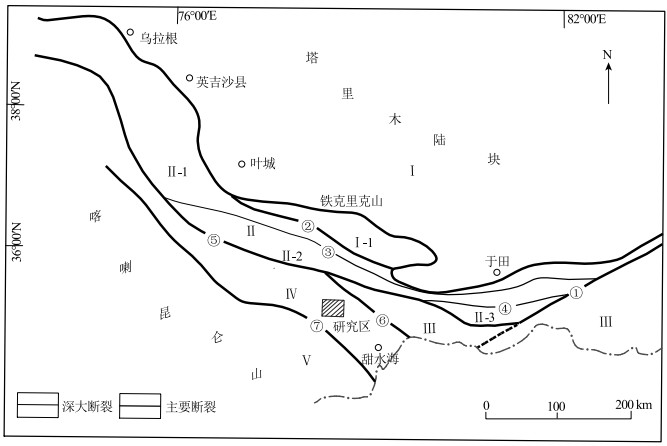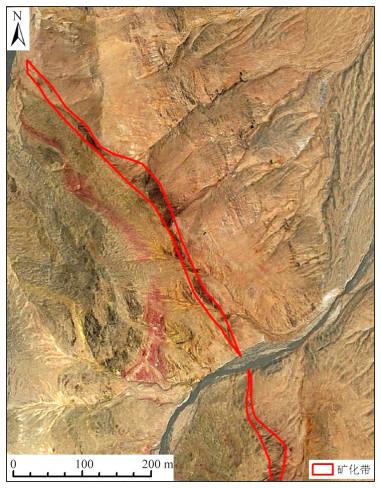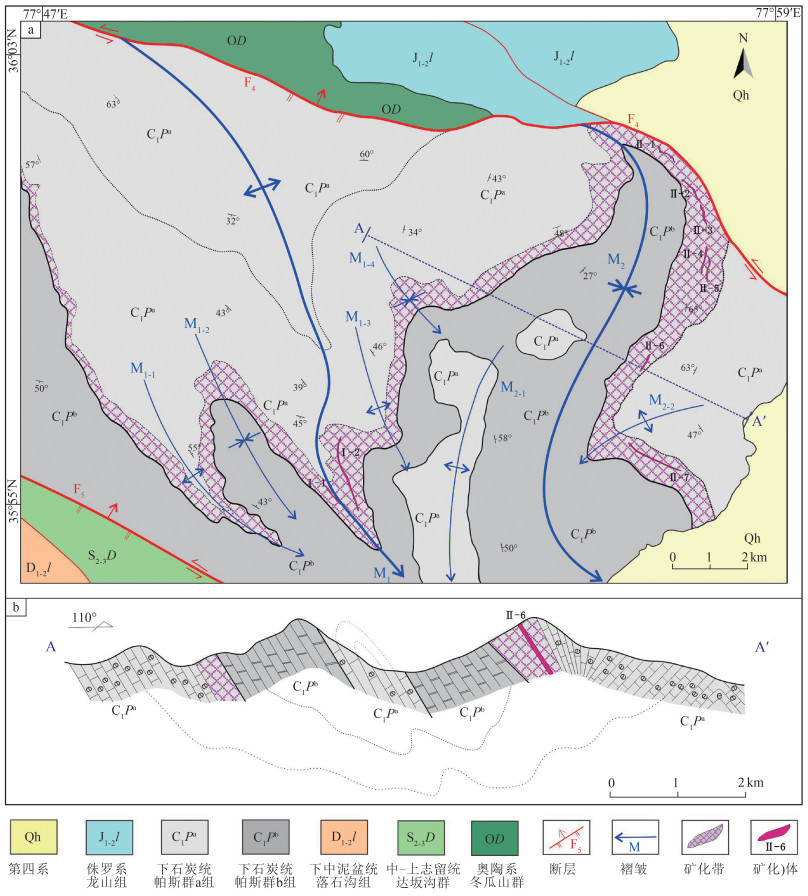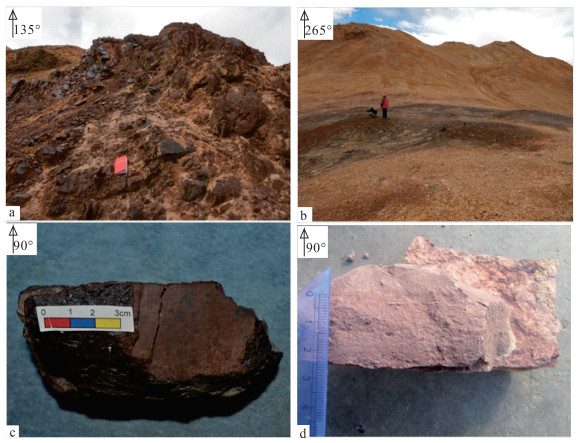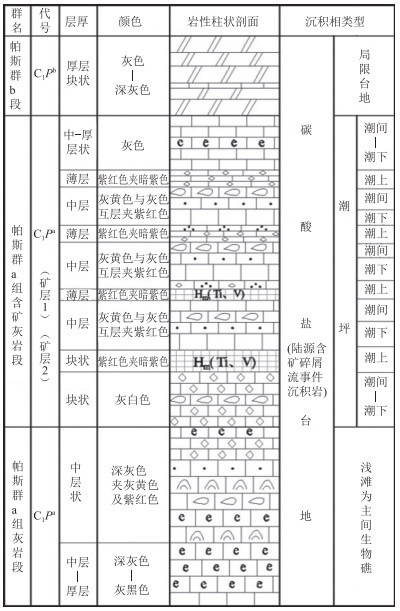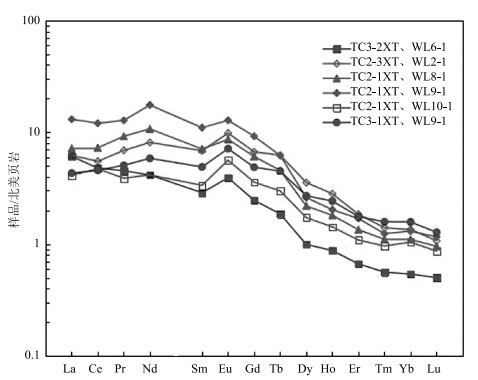Geology and genesis of the Dahuangshan REE-Nb-Fe polymetallic mineralization zone in Karakoram Range
-
摘要:
对喀喇昆仑山大黄山稀土-铌-铁钛多金属矿化带地质特征及矿床成因进行研究,为该区找矿勘查工作部署提供依据。通过详细的野外地质调查,在总结大黄山稀土-铌-铁钛多金属矿化带地质特征的基础上,配合镜下鉴定、矿床地球化学分析,探讨矿床成因类型与成矿作用,分析成矿期后的构造变形,预测矿化体的空间就位,提出找矿方向和找矿思路。大黄山稀土-铌-铁钛多金属矿化带含矿建造沉积环境为近陆滨-浅海碳酸盐岩台地相。矿化带处于石炭系帕斯群灰岩组(a组)上段(含矿泥质灰岩段)上部,区内延伸大于30km,西段发现2条矿化体(Ⅰ-1、Ⅰ-1),东段发现7条矿化体(Ⅱ-1~Ⅱ-7)。单矿化体一般长170~2000 m,厚度10~32 m,矿化体产状与地层产状一致,层控特征明显。矿石化学测试结果表明,矿化体内含Fe、Al、Ti、LREE、Nb、Ta等多种金属成矿元素。矿床成因类型为近陆滨海相沉积型。矿源为古陆源区红土型风化壳,以沉积物重力流和胶体溶液混合流体形式快速搬运,并在近陆滨岸地带以事件沉积作用快速卸载堆积而成。成矿期后,含矿建造遭受了强烈的构造改造,形成了总体呈NWW向展布的断褶带,带内发育的复式-叠加反"S"型褶皱构造构成了区内最特征的控矿构造样式。该带找矿前景好,找矿潜力大,通过进一步的矿产地质工作,有望在该带实现Fe、Al、Ti,尤其是稀有、稀土元素的重要找矿突破。
Abstract:The study on geology and genesis of the rare earth niobium iron titanium polymetallic mineralization zone in Dahuangshan, Kunlun Mountain, Kara can provide the basis for the exploration work in this area.Based on detailed field geological survey and summarizing of the geological characteristics of the Dahuangshan RE-Nb-Fe-Ti deposit, together with microscopic identification and geochemical analysis, the genetic types and mineralization of the iron ore are discussed.The analysis of structural deformation after metallogenic period can lead to the prediction of orebody location and prospecting target generation.The depositional environment of the ore-bearing formation in the Dahuangshan REE-Nb-Fe-Ti mineralization belt is littoral-shallow sea carbonate platform facies.The mineralization zone is located in the upper part (limestone Formation) of the Pasi Group (ore-bearing argillaceous limestone), and extends over 30 km in the area, two mineralized bodies (Ⅰ-1, Ⅰ-1) were found in the west section, and seven mineralized bodies (Ⅱ-1~Ⅱ-7) were found in the east section, Single mineralized bodies are generally 170-2000 m long and 10-32 m thick.whose attitude is consistent with strata.The ore assaying show that the mineralized bodies contain RE-Nb-Fe-Ti and other metallogenic elements.The genetic type of the deposit is offshore marine sedimentary type.The ore source is lateritic weathering crust in ancient continental area.It is presumed that the original rock is rapidly transported by mixing fluid of sediment gravity flow and colloidal solution, and rapidly unloaded and accumulated by event sedimentation in coastal zone.After the metallogenic period, the ore-bearing formation underwent intense structural transformation.The mineralized layer and the ore-bearing formation were deformed synchronously with various ore-controlling structures.The eastern part of the ore-bearing formation is characterized by a compound-superimposed fold structure, while the western part is characterized by a compression fault block-steeply dipping monoclinic structure.This area shows great prospecting potential.Through further mineral geological work, it is expected to achieve important prospecting breakthroughs for Fe, Al and Ti, especially rare and rare earth elements.After the metallogenic period, the ore-bearing structure underwent a strong structural transformation, and formed a fault-fold belt with NWW direction on the whole.The compound-superimposed inverted "S" fold structure developed in the belt constituted the most characteristic ore-controlling structural style in the area. This area shows great prospecting potential.Through further mineral geological work, it is expected to achieve important prospecting breakthroughs for Fe, Al and Ti, especially rare and rare earth elements.
-
大兴安岭是中国东北地区北东东向的巨型山脉,北起黑龙江,南至西拉木伦河上游谷地,全长约1400 km,宽约200 km。大兴安岭山脉的西侧为蒙古高原,东侧为松辽盆地,其与南部的太行山、巫山、雪峰山共同构成中国地势的第二、三阶梯的分界线。大地构造位置上,大兴安岭位于巨大的中亚造山带东段(图 1-a),自古生代以来,该地区先后经历了古亚洲洋、蒙古-鄂霍茨克洋和环太平洋构造体系的叠加改造,发育大规模的构造岩浆活动[2, 13-16]。其中,早白垩世岩浆活动最强烈,构成了大兴安岭的主体。伴随着该期岩浆活动,大兴安岭南段地区发育了大规模斑岩型铜钼矿、岩浆热液型银铅锌矿、矽卡岩型银铅锌矿和铁锡矿等成矿作用,成为中国北方一个重要的多金属成矿区[17-20]。因而,大兴安岭南段早白垩世岩浆活动和成矿地质背景一直是研究的热点和焦点之一[20-23]。
对于大兴安岭早白垩世岩浆活动形成的地质背景,长期以来,一直存在较大的认识分歧。一些学者认为,大兴安岭处于东北亚地幔柱影响范围内,中生代岩浆活动与地幔柱上涌有关[3, 24-26];另一些学者认为,太平洋板块的俯冲引起欧亚大陆东侧岩石圈加厚,大兴安岭岩浆活动与加厚的岩石圈的拆沉作用有关[21, 27-30];还有一些学者认为,大兴安岭岩浆活动与北侧鄂霍茨克洋的闭合引起的造山带的后碰撞伸展有关[30-33]。此外,还有一些学者认为,大兴安岭岩浆活动具有双峰式特征,形成于大陆裂谷环境[34-36]。
在以往的工作中,前人对大兴安岭早白垩世构造背景的研究主要集中在区内分布较广的火山岩和花岗岩[3-4, 34, 36-39]。作为深部来源的岩石探针,尽管中、基性岩浆岩在大兴安岭地区出露较少,但它们对于揭示岩石圈地幔的性质及深部动力学过程具有重要意义[15, 40-41]。本文通过对位于大兴安岭南段内蒙古林西县兰家营子地区早白垩世辉长闪长岩开展详细的岩石学、年代学和地球化学研究,揭示岩体的成因,并结合区域地质资料探讨大兴安岭南段地区早白垩世岩浆岩形成的构造背景。
1. 区域地质背景与岩石学特征
大兴安岭南段位于中亚造山带东南部(图 1-a)。该地区在古生代经历了与古亚洲洋演化相关的地质作用,发育贺根山、林西、西拉木伦河等多条古生代蛇绿岩带、晚古生代岛弧及增生杂岩带[42-47]。中生代以来,该地区先后经历了蒙古-鄂霍茨克洋的闭合与西太平洋俯冲等作用的叠加改造,发育广泛的火山岩、花岗岩、沉积盆地等。新生代以来,主要发育陆内伸展有关的幔源玄武岩[13, 48]。
研究区位于大兴安岭南段西拉木伦河以北的林西地区(图 1-b)。该区出露最古老的地层单元为早二叠世大石寨组安山岩和熔结凝灰岩,被晚二叠世—早三叠世林西组粉砂质板岩及砂岩覆盖。研究区缺失中、晚三叠世—早侏罗世地层沉积,晚侏罗世—早白垩世陆相火山-沉积岩地层不整合覆盖在上述地层之上(图 2)。侵入岩方面,林西地区发育早三叠世花岗闪长岩、二长花岗岩,以及早白垩世钾长花岗岩、花岗斑岩等[8, 16, 40, 49-51]。早白垩世辉长闪长岩和闪长岩在林西地区多以小岩株或岩脉的形式呈北东向分布。其中,兰家营子岩体位于内蒙古林西县的西北约10 km,岩体南侧侵入林西组,北侧和西侧与中生代花岗岩呈构造接触,中部和东侧被第四系北西向冲沟切割(图 2)。
![]() 图 2 林西地区地质图和采样位置②Figure 2. Geological map with the sampling location of the Linxi area
图 2 林西地区地质图和采样位置②Figure 2. Geological map with the sampling location of the Linxi area辉长闪长岩风化面呈红褐色,新鲜面为灰黑色,致密块状构造(图 3-a)。岩石主要由斜长石和单斜辉石组成,呈半自形粒状结晶结构(图 3-b)。斜长石呈较自形板条状,长0.5~1.5 mm,宽0.2~0.5 mm,含量70%~75%,发育聚片双晶和环带结构(图 3-c);辉石呈短柱状和粒状,粒径约0.5 mm,含量25%~30%,部分较大的单斜辉石中含不规则的橄榄石,构成典型的包橄结构(图 3-d)。此外,岩石中可见少量锆石、磷灰石等副矿物。
2. 分析方法
2.1 全岩元素地球化学
岩石化学分析样品的制备在河北省区域地质矿产调查研究所实验室完成。经薄片显微镜下鉴定后,选择新鲜样品用于地球化学分析,首先将岩石样品在颚式破碎机上进行粗碎,然后在玛瑙钵体的研磨机上研磨至200目以下,样品加工过程均在无污染设备中进行。主量和微量元素分析测试在武汉上谱分析科技有限公司完成。其中,主量元素分析测试是利用日本理学ZSX Primus Ⅱ X射线荧光光谱仪(XRF)完成的,测定精度均可达0.2%,分析误差一般优于5%。微量元素利用Agilent 7500a ICP-MS分析完成,对美国地质调查局(USGS)标准参考物质BCR-2、BHVO-2和AGV-a的分析结果表明,微量元素的分析精度和准确度一般优于5%,详细的样品处理和分析流程见Liu等[52]。
2.2 锆石U-Pb定年和Lu-Hf同位素分析
锆石分选在河北省区域地质矿产调查研究所实验室完成。在锆石分选过程中,将挑选出裂隙相对较少,表面干净,透明度较高的锆石制作环氧树脂样品靶,经过打磨和抛光后,在自然资源部大陆构造与动力学重点实验室Nova Nano SEM 450场发射扫描电子显微镜上进行阴极发光(CL)图像采集。锆石定年在武汉上谱分析科技有限责任公司进行,采用激光剥蚀等离子质谱体分析技术(LA-ICP-MS),应用GeoLas2005准分子激光剥蚀系统和Agilent 7500a型ICP-MS进行锆石U-Pb测定,激光束斑直径为32 μm。U-Pb同位素定年中采用锆石标准91500作外标进行同位素分馏校正,详细的实验原理和流程见参考文献[48]。对分析数据的离线处理采用软件ICPMSDataCal[52-53]完成。锆石样品的U-Pb年龄谐和图绘制和年龄加权平均计算均采用程序Isoplot(ver 3.00)[54]完成。
锆石原位Hf同位素分析测试在锆石U-Pb定年基础上进行,测试工作在中国地质科学院矿产资源研究所Finnigan Neptune型多接收等离子质谱(MC-ICP-MS)和Newwave UP213激光剥蚀系统上完成。分析过程中采用的激光束斑直径为44 μm,使用锆石国际标样GJ1为参考物质,分析点在U-Pb定年分析点的相同位置或附近。仪器的运行条件、详细的分析过程和数据处理见侯可军等[55]。
3. 分析结果
3.1 锆石U-Pb同位素年龄
测年样品采自兰家营子岩体中部,地理坐标为北纬43°40′45.6″、东经117°56′23.3″(图 2)。所测锆石均为无色-浅褐色,晶体为短柱状和粒状晶体,长宽比介于1:1~2:1之间,粒径为0.1~0.2 mm。在阴极发光图像(图 4-a)上,锆石阴极发光特征较暗,可能与锆石中Th和U含量较高有关[56](表 1);发育较宽的韵律环带,显示基性岩浆岩中锆石的特征;锆石的Th/U值多介于0.56~1.83之间,反映典型岩浆成因的特征[57-58]。24个分析点均分布在谐和线上,锆石206Pb/238U年龄加权平均值为145.6±0.6 Ma(n=24),MSWD=0.96(1σ)(图 4-b),表明岩体形成于早白垩世早期。
表 1 兰家营子地区辉长闪长岩LA-ICP-MS锆石U-Th-Pb分析数据Table 1. U-Th-Pb age of LA-ICP-MS zircon from the Lanjiayingzi gabbrodiorite点号 含量/10-6 232Th/238U 同位素比值 年龄/Ma Pb 232Th 238U 207Pb/206Pb ±1σ 207Pb/235U ±1σ 206Pb/238U ±1σ 207Pb/206Pb ±1σ 207Pb/235U ±1σ 206Pb/238U ±1σ DX03-1-01 39.1 1043 1370 0.76 0.0492 0.0017 0.1536 0.0051 0.0226 0.0002 154 77.8 145 4.5 144 1.4 DX03-1-02 34.7 808 1264 0.64 0.0472 0.0017 0.1498 0.0055 0.0228 0.0002 61.2 81.5 142 4.8 145 1.6 DX03-1-03 40.4 1088 1414 0.77 0.0491 0.0016 0.1561 0.0050 0.0229 0.0002 150 80.5 147 4.4 146 1.4 DX03-1-04 41.2 1040 1471 0.71 0.0492 0.0016 0.1555 0.0052 0.0226 0.0002 167 77.8 147 4.6 144 1.4 DX03-1-05 72.6 2424 2393 1.01 0.0485 0.0014 0.1545 0.0042 0.0228 0.0002 124 66.7 146 3.7 145 1.2 DX03-1-06 53.6 1870 1729 1.08 0.0488 0.0016 0.1553 0.0050 0.0228 0.0002 139 77.8 147 4.4 145 1.4 DX03-1-07 38.5 920 1372 0.67 0.0477 0.0017 0.1536 0.0056 0.0230 0.0002 83.4 85.2 145 4.9 146 1.6 DX03-1-08 21.32 472 788 0.60 0.0456 0.0019 0.1460 0.0060 0.0230 0.0003 138 5.3 146 1.6 DX03-1-09 27.90 587 999 0.59 0.0495 0.0018 0.1592 0.0054 0.0232 0.0002 172 83.3 150 4.7 148 1.5 DX03-1-10 58.1 1710 1993 0.86 0.0471 0.0014 0.1502 0.0044 0.0228 0.0002 57.5 66.7 142 3.9 146 1.3 DX03-1-11 38.6 1139 1271 0.90 0.0480 0.0017 0.1559 0.0051 0.0233 0.0002 98.2 88.0 147 4.5 148 1.5 DX03-1-12 49.4 1292 1772 0.73 0.0493 0.0016 0.1542 0.0051 0.0224 0.0002 161 77.8 146 4.4 143 1.4 DX03-1-13 213 10678 5844 1.83 0.0494 0.0012 0.1583 0.0038 0.0229 0.0002 169 62.0 149 3.4 146 1.3 DX03-1-14 144.0 5856 4321 1.36 0.0491 0.0013 0.1568 0.0039 0.0229 0.0002 154 56.5 148 3.4 146 1.3 DX03-1-15 16.84 429 578 0.74 0.0491 0.0021 0.1567 0.0064 0.0230 0.0003 150 100 148 5.7 146 1.7 DX03-1-16 29.5 798 1026 0.78 0.0492 0.0020 0.1548 0.0062 0.0225 0.0002 167 99.1 146 5.5 144 1.5 DX03-1-17 18.31 551 638 0.86 0.0493 0.0023 0.1563 0.0075 0.0226 0.0003 165 139 147 6.6 144 1.6 DX03-1-18 30.5 889 1037 0.86 0.0496 0.0020 0.1566 0.0061 0.0228 0.0003 176 125.0 148 5.4 146 1.7 DX03-1-19 25.93 538 955 0.56 0.0485 0.0021 0.1562 0.0067 0.0231 0.0003 120 100 147 5.9 147 1.7 DX03-1-20 35.5 779 1276 0.61 0.0476 0.0017 0.1518 0.0055 0.0229 0.0002 79.7 85.2 143 4.9 146 1.6 DX03-1-21 40.3 1100 1395 0.79 0.0486 0.0016 0.1538 0.0049 0.0228 0.0002 132 77.8 145 4.3 145 1.5 DX03-1-22 23.04 486 826 0.59 0.0481 0.0019 0.1546 0.0061 0.0230 0.0002 102 92.6 146 5.4 147 1.6 DX03-1-23 59.2 2051 1903 1.08 0.0485 0.0016 0.1563 0.0048 0.0232 0.0003 124 71.3 147 4.2 148 1.7 DX03-1-24 62.4 2556 1915 1.34 0.0492 0.0014 0.1548 0.0044 0.0226 0.0002 167 73.1 146 3.9 144 1.4 3.2 地球化学特征
兰家营子辉长闪长岩的主量、微量和稀土元素分析结果见表 2。
表 2 兰家营子辉长闪长岩主量、微量和稀土元素含量Table 2. Contents of major and trace elements, as well as REE of the Lanjiayingzi gabbrodiorite样品号 DX03-1 DX03-2 DX03-3 DX03-4 DX03-5 样品号 DX03-1 DX03-2 DX03-3 DX03-4 DX03-5 SiO2 54.09 53.7 53.38 54.45 53.45 Cr 84.4 94.3 109 83.1 84.2 TiO2 0.99 1.05 1.23 1.15 1.16 Hf 2.82 2.88 2.94 2.71 2.81 Al2O3 18.49 18.18 17.95 18.61 18.23 Cs 3.09 3.23 2.8 2.19 2.22 TFe2O3 7.95 8.21 8.33 7.53 8.13 Sc 13.6 14.6 15.9 13.8 13.8 MnO 0.11 0.12 0.12 0.12 0.12 Ta 0.3 0.32 0.37 0.34 0.33 MgO 5.54 5.7 5.73 5.44 5.56 Co 29.4 31.4 31.5 27.2 31.3 CaO 7.63 7.66 7.81 7.59 7.73 U 0.86 0.96 0.83 1 0.89 Na2O 3.97 3.92 3.85 4.05 3.9 Sn 1.17 1.11 1.18 1.1 1.04 K2O 1.43 1.34 1.35 1.41 1.35 La 32.9 18.7 102 17 14.8 P2O5 0.22 0.24 0.23 0.26 0.29 Ce 54.7 37.1 140 36 33.6 烧失量 0.08 0.21 0.05 0.16 0.31 Pr 5.88 4.52 12.5 4.53 4.44 总计 100.58 100.39 100.1 100.83 100.29 Nd 22.5 18.9 41 19.2 19.2 A/CNK 0.84 0.83 0.82 0.85 0.83 Sm 4.08 3.89 5.36 4 4.08 Ba 461 452 467 455 444 Eu 1.51 1.48 1.72 1.53 1.47 Rb 27.8 27.7 26.9 28.5 25.9 Gd 3.54 3.43 4.06 3.66 3.68 Sr 818 828 842 839 820 Tb 0.49 0.51 0.55 0.52 0.55 Y 14.8 15.9 16.1 15.7 16.1 Dy 2.8 2.93 3.2 3.09 3.17 Zr 118 115 114 106 111 Ho 0.53 0.55 0.58 0.57 0.57 Nb 4.41 4.71 5.6 5.03 5.02 Er 1.39 1.47 1.45 1.45 1.46 Th 2.57 2.69 4.17 2.78 2.38 Tm 0.21 0.21 0.22 0.22 0.22 Pb 6.62 6.45 6.66 6.84 6.75 Yb 1.19 1.37 1.32 1.32 1.32 Ga 20.6 20.4 21 20.8 20.5 Lu 0.17 0.19 0.2 0.2 0.2 Zn 76.5 83.5 85.2 75.7 84 Mg# 37.39 37.31 37.09 38.24 36.96 Cu 11.8 9.51 10.7 9.93 13.9 δEu 1.21 1.24 1.13 1.22 1.16 Ni 30.2 32.1 32.6 25.2 31.2 (La/Yb)N 18.64 9.20 52.10 8.68 7.56 V 140 147 169 157 150 注:主量元素含量单位为%,微量和稀土元素含量单位为10-6 3.2.1 主量元素
从表 2可以看出,辉长闪长岩的SiO2含量为53.38%~54.45%,MgO和TFe2O3含量分别为5.44%~5.73%和7.53%~8.33%,Mg#值介于36.96~38.24之间。岩石的Al2O3含量为17.95%~18.49%,CaO含量为7.59%~7.81%,Na2O含量为3.85%~4.05%,K2O含量为1.34%~1.43%,A/CNK值为0.82~0.85,属于偏铝质岩石。在侵入岩TAS图解(图 5-a)中,样品点均落在辉长岩和闪长岩之间,属于偏基性岩石;在SiO2-K2O图解中,显示钙碱性系列岩浆岩的特征(图 5-b)。
3.2.2 微量和稀土元素
辉石闪长岩的稀土元素总量(∑REE)为88.76×10-6~136.21×10-6,(La/Yb)N值在7.56~18.64之间。在稀土元素配分图中,表现为轻稀土元素相对富集,重稀土元素相对平坦的右倾型特征(图 6-a),没有或显示轻微的正Eu异常(δEu=1.13~1.24)。微量元素表现为相对富集Ba、Sr等大离子亲石元素,亏损Nb、Ta等高场强元素的特征(图 6-b)。
3.3 锆石Hf同位素特征
兰家营子岩体锆石Hf同位素分析测试结果见表 3。从表 3可以看出,锆石Hf同位素组成均一,176Hf/177Hf值介于0.282838~0.282923之间,对应的εHf(t)值介于+5.4~+9.0之间,加权平均值为7.52±0.25。锆石的亏损地幔模式年龄(TDM)介于443~590 Ma之间,与兴蒙造山带东段显生宙以来的岩浆岩锆石Hf同位素组成特征类似[67](图 7)。
表 3 兰家营子辉长闪长岩锆石Lu-Hf同位素分析结果Table 3. Zircon Lu-Hf isotopic data of the Lanjiayingzi gabbrodiorite测点号 年龄/Ma 176Yb/177Hf 176Lu/177Hf 176Hf/177Hf 2σ εHf(0) εHf(t) 2σ TDM1/Ma fLu/Hf DX03-1-01 144 0.025142 0.000640 0.282888 0.000019 4.1 7.2 0.7 512 -0.98 DX03-1-02 145 0.021711 0.000557 0.282890 0.000016 4.2 7.3 0.6 508 -0.98 DX03-1-03 146 0.017745 0.000402 0.282911 0.000016 4.9 8.1 0.6 476 -0.99 DX03-1-04 144 0.036712 0.000868 0.282895 0.000019 4.3 7.4 0.7 505 -0.97 DX03-1-05 145 0.066984 0.001591 0.282905 0.000020 4.7 7.7 0.7 500 -0.95 DX03-1-07 146 0.022079 0.000523 0.282887 0.000017 4.1 7.2 0.6 512 -0.98 DX03-1-08 146 0.020129 0.000501 0.282886 0.000015 4.0 7.2 0.5 512 -0.98 DX03-1-09 148 0.021605 0.000490 0.282877 0.000017 3.7 6.9 0.6 525 -0.99 DX03-1-10 146 0.031634 0.000729 0.282886 0.000021 4.0 7.2 0.8 515 -0.98 DX03-1-11 148 0.053899 0.001231 0.282904 0.000019 4.7 7.8 0.7 497 -0.96 DX03-1-12 143 0.032645 0.000768 0.282902 0.000017 4.6 7.7 0.6 494 -0.98 DX03-1-13 146 0.027665 0.000595 0.282911 0.000019 4.9 8.1 0.7 479 -0.98 DX03-1-14 146 0.053093 0.001158 0.282896 0.000018 4.4 7.5 0.6 507 -0.97 DX03-1-15 146 0.033945 0.000623 0.282898 0.000024 4.5 7.6 0.9 497 -0.98 DX03-1-16 144 0.042239 0.000877 0.282923 0.000019 5.3 8.4 0.7 466 -0.97 DX03-1-17 144 0.031130 0.000635 0.282908 0.000026 4.8 7.9 0.9 483 -0.98 DX03-1-18 146 0.045799 0.000869 0.282938 0.000025 5.9 9.0 0.9 443 -0.97 DX03-1-19 147 0.015344 0.000297 0.282887 0.000021 4.1 7.3 0.7 509 -0.99 DX03-1-20 146 0.019434 0.000419 0.282877 0.000020 3.7 6.9 0.7 524 -0.99 DX03-1-22 147 0.040944 0.000848 0.282900 0.000021 4.5 7.7 0.8 497 -0.97 DX03-1-23 148 0.037534 0.000781 0.282914 0.000026 5.0 8.2 0.9 477 -0.98 DX03-1-24 144 0.056441 0.001153 0.282838 0.000029 2.3 5.4 1.0 590 -0.97 ![]() 图 7 兰家营子辉长闪长岩锆石Hf同位素演化图解(图a中兴蒙造山带东段和燕山褶皱带岩浆岩锆石εHf(t)范围据参考文献[67];图b为图a的局部放大)Figure 7. Zircon Hf isotope data evolution diagrams of the Lanjiayingzi gabbrodiorite
图 7 兰家营子辉长闪长岩锆石Hf同位素演化图解(图a中兴蒙造山带东段和燕山褶皱带岩浆岩锆石εHf(t)范围据参考文献[67];图b为图a的局部放大)Figure 7. Zircon Hf isotope data evolution diagrams of the Lanjiayingzi gabbrodiorite4. 讨论
4.1 兰家营子辉长闪长岩成因
兰家营子辉长闪长岩主要由斜长石和辉石组成,SiO2含量介于53.38%~54.45%之间,属于中基性岩浆岩(图 3-b)。对于中基性岩浆岩的成因,一般有如下几种观点:玄武质岩石部分熔融、幔源原始岩浆的同化混染和分离结晶作用(AFC)或岩浆混合作用[68-69]。宏观上,兰家营子辉长闪长岩的岩性较均一,缺少指示岩浆混合作用的暗色微粒包体;微观上,作为主要造岩矿物的斜长石发育成分环带,单斜辉石发育包橄结构,指示岩石是由更基性的岩浆经历基性斜长石、橄榄石等矿物分离结晶作用的产物,而并非岩浆混合作用成因。同时,橄榄石和基性斜长石的存在指示原始岩浆的成分应为玄武质,代表其应为地幔部分熔融的产物。
从地球化学特征看,岩石相对富集Rb、Ba、Sr等大离子亲石元素(LILE),亏损Nb、Ta等高场强元素(HFSE),具有俯冲带岩浆岩的地球化学特征[70-71],指示岩浆形成过程中可能受到地壳混染,或者地幔源区遭受了俯冲板片熔流体的交代作用。如果岩浆在形成过程中受到地壳的混染,在岩石学特征上,辉长闪长岩中可能含有长英质捕虏体,而在岩体中目前未见捕虏体;在地球化学特征上,岩浆表现为相对富集Zr和Hf元素[72-73]和相对亏损Eu元素的特征,但在本文的原始地幔标准化微量元素蛛网图(图 6-b)上,辉长闪长岩并未表现出明显Zr和Hf元素的正异常,也不存在负Eu异常,甚至表现为轻微的正Eu异常,也暗示其受到地壳混染的可能性很小。从模式年龄(图 7)看,锆石的TDM介于443~590 Ma之间,与古亚洲洋俯冲相关的大多数岩浆岩年龄一致。前人研究表明,古亚洲洋在晚二叠世—早三叠世已经闭合。结合岩石地球化学特征,笔者认为,兰家营子岩体的锆石εHf(t)值反映的是古亚洲洋闭合之前或过程中遭受流体交代作用形成的岩石圈地幔在早白垩世发生部分熔融的结果。
大地构造位置上,研究区位于中亚造山带东南部(图 1-a)。在古生代该区经历了古亚洲洋的持续俯冲增生,发育多期与俯冲相关的岩浆活动[40, 74-78]。考虑到岩体的岩石地球化学和锆石Hf同位素组成特征,笔者认为,兰家营子辉长闪长岩源于古生代受俯冲流体交代形成的亏损岩石圈地幔的部分熔融,而后经历了基性斜长石和橄榄石分离结晶作用。
4.2 大兴安岭南段早白垩世早期岩浆岩组合及构造环境
除兰家营子辉长闪长岩外,大兴安岭南段地区早白垩世早期还广泛发育辉长岩、石英闪长岩、碱长花岗岩、正长花岗岩、二长花岗岩、花岗斑岩等侵入岩[8, 26, 40, 59-61],以及玄武质安山岩、英安岩、流纹岩等火山岩[32, 35-36]。在TAS图解(图 5-a)中,显示类似双峰式岩石组合的特征[79],其中,敖仑敖包二长花岗岩、龙头山碱长花岗岩、敖包吐正长花岗岩等具有A型花岗岩的地球化学特征[8, 26, 59]。
双峰式岩浆活动可形成于大陆裂谷、后碰撞、弧后盆地等构造环境[80-81],但不同构造环境下,双峰式岩浆岩具有不同的岩石组合和地球化学特征。首先,大兴安岭南段早白垩世不存在海相沉积环境,可以排除弧后盆地的可能。对于大陆裂谷环境而言,基性端元通常包括富碱质的拉斑-碱性玄武岩、SiO2不饱和的碧玄岩、霞石岩和超钾质的白榴岩、碳酸岩等;酸性端元包括偏碱质的粗面岩、响岩、碱性流纹岩、花岗岩等[80]。大兴安岭南段早白垩世早期双峰式组合的基性端元包括玄武质安山岩、辉长闪长岩等,属于钙碱性系列岩石;基性端元包括流纹岩、碱长花岗岩、二长花岗岩等,属于钙碱性-钾玄岩系列岩石,与典型的裂谷环境下双峰式组合不同,且本文辉长闪长岩的地球化学特征表明其形成于岩石圈地幔的部分熔融,而裂谷环境下双峰式火山岩的基性端元具有软流圈地幔的特征,故也可以排除它们属于大陆裂谷环境下的双峰式岩浆活动。后碰撞环境岩浆岩的基性端元表现为相对富集HFSE与LREE,Th/Ta值高(大于5),相对亏损Nb、Ti等元素,与本文辉长闪长岩的地球化学特征相似;酸性端元具有过碱性花岗岩、碱性花岗岩与钙碱性花岗岩共生,且具有与A型花岗岩相似的地球化学特征的特点[80],也与该地区早白垩世花岗岩岩石组合及地球化学特征相似[8, 26, 32, 36]。因此,大兴安岭南段在早白垩世早期的双峰式岩浆活动可能与后碰撞的构造环境有关。
前人研究表明,蒙古-鄂霍茨克洋闭合的时间在中—晚侏罗世[82-87],该洋盆的闭合造成中国东北的碰撞造山和隆升[13]。在时间上,辉长闪长岩的形成时间稍晚于鄂霍茨克洋的闭合时间;在空间上,大兴安岭南段早白垩世早期岩浆活动呈北东东向展布(图 1-b),平行于蒙古-鄂霍茨克洋缝合带,且与太平洋俯冲带呈大角度斜交。综上所述,笔者认为,大兴安岭南段早白垩世早期岩浆活动与蒙古-鄂霍茨克洋闭合引起的碰撞后伸展背景有关。
5. 结论
(1) 大兴安岭南段兰家营子辉长闪长岩的锆石U-Pb年龄为145.6±0.6 Ma,属于早白垩世早期侵入体。
(2) 辉长闪长岩起源于受俯冲流体交代的亏损岩石圈地幔,并经历了橄榄石和斜长石的分离结晶作用。
(3) 大兴安岭南段早白垩世早期岩浆岩具有双峰式特征,可能形成于蒙古-鄂霍茨克洋闭合引起的碰撞后伸展环境。
致谢: 成文过程中得到项目组合体成员的帮助和支持,中国地质调查局西安地质调查中心杨合群教授对本文提出了宝贵意见,在此一并表示感谢。 -
图 8 大黄山稀土-铌-铁-钛多金属矿化带内矿石稀土元素北美页岩标准化分布(标准化数据引自参考文献[50])
Figure 8. REE distribution in the Dahuangshan REE-Nb-Fe-Tipolymetallic mineralization zone
表 1 大黄山稀土-铌-铁-钛多金属矿化带内矿(化)体基本特征
Table 1 Ore bodies in Dahuangshan REE-Nb-Fe-Ti polymetallic mineralization zone
序号 矿体编号 形态 产状 长度/m 平均厚度/m Nb2O5/10-6 Ta2O5/10-6 REE2O3/10-6 Ti/% TFe/% 控制手段 1 Ⅰ-1 层状 242°∠44° 800 12 4.83 33.30 地表追索+探槽 2 Ⅰ-2 层状 232°∠42° 2000 10 4.90 22.97 3 Ⅱ-1 层状 222°∠62° 658 22 4.80 19.28 4 Ⅱ-2 层状 245°∠81° 743 15.9 476 29 1731 4.99 20.00 5 Ⅱ-3 层状 215°∠40° 580 32.3 276 19 918 3.35 21.45 6 Ⅱ-4 层状 260°∠56° 660 26.1 739 42 669 4.39 19.28 7 Ⅱ-5 层状 335°∠30° 631 22 403 23.62 544 4.01 17.88 8 Ⅱ-6 层状 210°∠55° 170 18 5.89 23.40 9 Ⅱ-7 层状 265°∠78° 780 20 5.36 20.45 表 2 大黄山稀土-铌-铁钛多金属矿化带内钛元素物相分析结果
Table 2 Phase analysis of titanium of ores from the Dahuangshan REE-Nb-Fe-Ti polymetallic mineralization zone
物相种类 钛铁矿中钛 金红石中钛 钛磁铁矿中钛 榍石和硅酸盐中钛 总量 TiO2/% TiO2/% TiO2/% TiO2/% TiO2/% 含量 4.78 1.89 1.20 < 0.01 7.87 百分比/% 60.74 24.01 15.25 0 100 表 3 大黄山稀土-铌-铁-钛多金属矿化带内矿石地球化学测试结果
Table 3 Assaying results of ores in the Dahuangshan REE-Nb-Fe-Ti polymetallic mineralization zone
样品 MnO/TiO2 Na/Mg Fe/Ti Al/(Al+Fe+Mn) D6-1 0.03 0.69 0.92 0.85 D2-1 0.01 0.92 4.76 0.47 D8-1 0.001 0.13 2.86 0.48 D9-1 0.002 6.98 1.76 0.77 D10-1 0.01 2.78 7.07 0.38 D11-1 0.01 2.69 4.57 0.43 表 4 大黄山稀土-铌-铁-钛多金属矿化带内矿石稀土元素测试结果
Table 4 REE assaying results of ores from the Dahuangshan REE-Nb-Fe-Ti polymetallic mineralization zone
10-6 样品号 TC3-2XT
WL6-1TC2-3XT
WL2-1TC2-1XT
WL8-1TC2-1XT
WL9-1TC2-1XT
WL10-1TC3-1XT
WL9-1La 192.00 196.00 226.00 412.00 130.00 136.00 Ce 318.00 366.00 483.00 802.00 313.00 304.00 Pr 35.80 54.40 72.80 101.00 30.70 40.00 Nd 112.00 219.00 290.00 474.00 112.00 158.00 Sm 17.00 40.40 41.80 64.90 19.80 28.90 Eu 4.62 11.60 10.20 15.10 6.63 8.42 Gd 12.80 34.80 31.60 48.00 18.60 25.30 Tb 1.47 4.93 3.60 4.89 2.36 3.55 Dy 5.75 20.60 12.70 15.10 10.00 15.70 Ho 0.91 2.93 1.88 2.11 1.48 2.52 Er 2.26 6.28 4.57 5.75 3.69 6.00 Tm 0.28 0.70 0.55 0.62 0.48 0.79 Yb 1.60 4.01 3.26 3.87 3.09 4.68 Lu 0.22 0.47 0.42 0.51 0.38 0.56 Y 21.50 61.30 38.90 45.40 37.00 61.20 LREE 679.42 887.40 1123.80 1869.00 612.13 675.32 HREE 25.29 74.72 58.58 80.85 40.08 59.10 LREE/HREE 26.87 11.88 19.18 23.12 15.27 11.43 LaN/YbN 11.31 4.61 6.54 10.04 3.97 2.74 -
程裕淇. 中国区域地质概论[M]. 北京: 地质出版社, 1994: 1-200. 潘裕生. 昆仑山区构造区划初探[J]. 自然资源学报, 1989, 4(3): 196-203. doi: 10.3321/j.issn:1000-3037.1989.03.002 潘裕生. 青藏高原第五缝合带的发现与论证[J]. 地球物理学报, 1994, 37(2): 184-192. doi: 10.3321/j.issn:0001-5733.1994.02.006 Wang X, Zhang X, Gao J, et al. A slab break-off model for the submarine volcanic-hosted iron mineralization in the Chinese Western Tianshan: Insights from Paleozoic subduction-related to post-collisional magmatism[J]. Ore Geology Reviews, 2018, 92: 144-160. doi: 10.1016/j.oregeorev.2017.11.015
Li W, Dong Y, Guo A, et al. Chronology and tectonic significance of Cenozoic faults in the Liupanshan Arcuate Tectonic Belt at the northeastern margin of the Qinghai-Tibet Plateau[J]. Journal of Asian Earth Sciences, 2013, 73: 103-113. doi: 10.1016/j.jseaes.2013.04.026
Wang C, Liu A, Wang H, et al. Recognition and tectonic implications of an extensive Neoproterozoic volcano-sedimentary rift basin along the southwestern margin of the Tarim Craton, northwestern China[J]. Precambrian Research, 2013, 257: 65-82.
Liu L, Ya B, Lei L, et al. Early Paleozoic granitic magmatism related to the processes from subduction to collision in South Altyn, NW China[J]. Science China Earth Sciences, 2015, 58: 1513-1522. doi: 10.1007/s11430-015-5151-1
Fan Y, Wan Y, Wang H, et al. Application of airborne hyperspectral remote sensing image data in the gold-silver-lead-zinc ore district of Huaniushan, Gansu, China[J]. Eologia Croatica, 2021, 74(1): 73-84 doi: 10.4154/gc.2021.04
巫建华, 刘帅. 大地构造学概论与中国大地构造学纲要[M]. 北京: 地质出版社, 2008. 杨克明. 论西昆仑大陆边缘构造演化及塔里木西南盆地类型[J]. 地质论评, 1994, 1: 9-18. doi: 10.3321/j.issn:0371-5736.1994.01.002 潘裕生, 周伟明, 许荣华, 等. 昆仑山早古生代地质特征与演化[J]. 中国科学(D辑), 1996, 26(4): 302-307. doi: 10.3321/j.issn:1006-9267.1996.04.003 潘裕生. 青藏高原的形成与隆升[J]. 地学前缘, 1999, 6(3): 153-163. doi: 10.3321/j.issn:1005-2321.1999.03.015 姜春发, 朱松年. 构造迁移论概述[J]. 中国地质科学院院报, 1992, 25: 1-14. https://www.cnki.com.cn/Article/CJFDTOTAL-DQXB199200000.htm 姜春发. 中央造山带几个重要地质问题及其研究进展(代序)[J]. 地质通报, 2002, 21(Z2): 453-455. http://dzhtb.cgs.cn/gbc/ch/reader/view_abstract.aspx?file_no=200208112&flag=1 姜春发, 杨经绥, 冯秉贵, 等. 昆仑开合构造[M]. 北京: 地质出版社, 1992: 161-168. 李涛, 王宗秀. 塔里木地块北部横向构造及断条模式[J]. 中国地质, 2006, 33(1): 14-27. https://www.cnki.com.cn/Article/CJFDTOTAL-DIZI200601001.htm 陆松年, 李怀坤, 陈志宏. 塔里木与扬子新元古代热-构造事件特征、序列和时代——扬子与塔里木连接(YZ-TAR)假设[J]. 地学前缘, 2003, 10(4): 321-326. doi: 10.3321/j.issn:1005-2321.2003.04.001 杨经绥, 王希斌, 史仁灯, 等. 青藏高原北部东昆仑南缘德尔尼蛇绿岩: 一个被肢解了的古特提斯洋壳[J]. 中国地质, 2004, 31(3): 225-239. doi: 10.3969/j.issn.1000-3657.2004.03.001 李文渊, 张照伟, 高永宝, 等. 秦祁昆造山带重要成矿事件及其构造演化响应[C]//陈毓川, 薛春纪, 张长青. 主攻深部挺进西部放眼世界——第九届全国矿床会议论文集. 北京: 地质出版社, 2008: 15-16. 康磊, 校培喜, 高晓峰, 等. 西昆仑西段晚古生代-中生代花岗质岩浆作用及构造演化过程[J]. 中国地质, 2015, 42(3): 533-552. doi: 10.3969/j.issn.1000-3657.2015.03.011 李文渊, 张照伟, 高永宝, 等. 秦祁昆造山带重要成矿事件与构造响应[J]. 中国地质. 2011, 38(5): 1135-1149. doi: 10.3969/j.issn.1000-3657.2011.05.002 孙海田, 李纯杰, 李锦荣, 等. 新疆西昆仑昆盖山地区铜矿资源找矿地质条件[J]. 中国地质, 1997, 24(11): 29-30. https://www.cnki.com.cn/Article/CJFDTOTAL-DIZI199711010.htm 王书来, 汪东波, 祝新友. 新疆西昆仑金(铜)矿找矿前景分析[J]. 地质找矿论丛, 2000, 15(3): 224-229. doi: 10.3969/j.issn.1001-1412.2000.03.004 西北地质矿产研究所. 西北地区矿产资源找矿潜力[M]. 北京: 地质出版社, 2006. 杨合群, 姜寒冰, 谭文娟, 等. 西北地区重要矿产概论[M]. 武汉: 中国地质大学出版社, 2017: 19. 李先军, 赵祖应. 西昆仑北段矿产分布特征及找矿方向浅析[J]. 地质与勘探, 2009, 45(2): 1-7. doi: 10.3969/j.issn.1001-1986.2009.02.001 李宝强, 杨万志, 赵树铭, 等. 西昆仑成矿带成矿特征及勘查远景[J]. 西北地质, 2006, 39(2): 128-142. doi: 10.3969/j.issn.1009-6248.2006.02.008 李文渊. 中国西北部成矿地质特征及找矿新发现[J]. 中国地质, 2015, 42(3): 365-380. doi: 10.3969/j.issn.1000-3657.2015.03.001 Qin Y, Feng Q, Chen G, et al. Devonian post-orogenic extension-related volcano-sedimentary rocks in the northern margin of the Tibetan Plateau, NW China: Implications for the Paleozoic tectonic transition in the North Qaidam Orogen[J]. Journal of Asian Earth Sciences. 2018, 156: 145-166. doi: 10.1016/j.jseaes.2018.01.009
Hou Q, Mou C, Wang Q, et al. Provenance and tectonic setting of the Early and Middle Devonian Xueshan Formation, the North Qilian Belt, China[J]. Geological Journal, 2018, 53: 1404-1422. doi: 10.1002/gj.2963
Fan Y, Wang H. Application of remote sensing to identify copper-lead-zinc deposits in the Heiqia Area of the West Kunlun Mountains, China[J]. Scientific Reports, 2020, (10): 12309. http://www.nature.com/articles/s41598-020-68464-7
Fan Y, Wang H, Yang X, et al. Application of high resolution remote sensing technology for the iron ore deposits of the West Kunlun mountains in China[J]. Eologia Croatica, 2021, 74(1): 57-72 doi: 10.4154/gc.2021.03
董永观, 郭坤一, 肖惠良, 等. 西昆仑地区成矿远景[J]. 中国地质, 2003, 30(2): 173-178. https://www.cnki.com.cn/Article/CJFDTOTAL-DIZI200302009.htm 褚少雄. 西昆仑及其邻区成矿地质背景及成矿规律探讨[D]. 中国地质大学硕士学位论文, 2008. 贾群子. 新疆西昆仑块状硫化物铜矿床[M]. 北京: 地质出版社, 1999. 侯增谦, 宋玉财, 李政, 等. 青藏高原碰撞造山带Pb-Zn-Ag-Cu矿床新类型: 成矿基本特征与构造控矿模型[J]. 矿床地质, 2008, 27(2): 123-144. doi: 10.3969/j.issn.0258-7106.2008.02.001 李文渊, 张照伟, 高永宝, 等. 秦祁昆造山带重要成矿事件与构造响应[J]. 中国地质, 2011, 38(5): 41-50. https://www.cnki.com.cn/Article/CJFDTOTAL-DIZI201105003.htm 赵佳楠, 刘正军. 新疆西昆仑造山带北缘中元古代帕什托克闪长岩侵入序列及其地质意义[J]. 中国地质, 2014, 41(1): 92-107. doi: 10.3969/j.issn.1000-3657.2014.01.007 高晓峰, 校培喜, 康磊, 等. 新疆塔什库尔干塔阿西一带火山岩成因及地质意义[J]. 地球科学-中国地质大学学报, 2013, 38(6): 1169-1182. https://www.cnki.com.cn/Article/CJFDTOTAL-DQKX201306002.htm 贠杰, 高晓峰, 校培喜, 等. 西昆仑下石炭统乌鲁阿特组火山岩地球化学特征及地质意义[J]. 中国地质, 2015, 42(3): 587-600. doi: 10.3969/j.issn.1000-3657.2015.03.014 新疆自治区地质矿产局. 新疆自治区区域地质志[M]. 北京: 地质出版社, 1993: 1-841. 王永, 李德贵, 肖序常, 等. 西昆仑山前晚新生代构造话动与青藏高原西北缘的隆升[J]. 中国地质, 2006, 33(1): 41-47. https://www.cnki.com.cn/Article/CJFDTOTAL-DIZI200601003.htm 于晓飞. 西昆仑造山带区域成矿规律研究[D]. 中国地质大学博士学位论文, 2008. 李荣社, 计文化, 杨永成, 等. 昆仑山及邻区地质[M]. 北京: 地质出版社, 2008: 1-5. 伍耀中, 乔耿彪, 陈登辉, 等. 昆仑-阿尔金成矿带金属矿产成矿条件与成矿远景预测[M]. 武汉: 中国地质大学出版社, 2016: 14. 计文化, 陈守建, 李荣社, 等. 青藏高原及邻区古生代构造-岩相古地理综合研究[M]. 武汉: 中国地质大学出版社, 2014: 112-116. Gao S, Ling W, Qiu Y, et al. Contrasting geochemical and Sm-Nd isotopic compositions of Archean metasediments from the Kongling high-grade terrain of the Yangtze craton: evidence for cratonic evolution and redistribution of REE during crustal anatexis[J]. Geochimica et Cosmochimica Acta, 1999, 63(13/14): 2071-2088. http://www.sciencedirect.com/science/article/pii/S0016703799001532
Sugisaki R, Yamamoto K, Adachi M. Triassic bedded cherts in central Japan are not pelagic[J]. Nature, 1982, 298(5875): 644-647. doi: 10.1038/298644a0
Murray R W, Buchholtz T B, Marilyn R, et al. Rare earth elements as indicators of different marine depositional environments in chert and shale[J]. Geology, 1990, 18(3): 268. doi: 10.1130/0091-7613(1990)018<0268:REEAIO>2.3.CO;2
Brookins D G. Aqueous geochemistry of rare earth elements[J]. Reviews in Mineralogy and Geochemistry, 1989, 21(1): 201-225.
刘平, 廖友常, 张雅静. 黔中-渝南石炭纪铝土矿含矿岩系中的海相沉积特征[J]. 中国地质, 2015, 42(2): 641-654 doi: 10.3969/j.issn.1000-3657.2015.02.022 刘长龄, 覃志安. 我国铝土矿中微量元素的地球化学特征[J]. 沉积学报, 1991, (2): 25-33. https://www.cnki.com.cn/Article/CJFDTOTAL-CJXB199102002.htm 巴多西G. 等著, 顾皓民, 等译, 红土型铝土矿[M]. 沈阳: 辽宁科学技术出版社, 1993. 张启明, 江新胜, 秦建华, 等. 黔北-渝南地区中二叠世早期梁山组的岩相古地理特征和铝土矿成矿效应[J]. 地质通报, 2012, 31(4): 558-568. doi: 10.3969/j.issn.1671-2552.2012.04.009 刘平, 廖友常. 黔中-渝南沉积型铝土矿区域成矿模式及找矿模型[J]. 中国地质, 2014, 41(6): 2063-2082. doi: 10.3969/j.issn.1000-3657.2014.06.020 -
期刊类型引用(6)
1. 顾玉超,陈仁义,杜继宇,鞠楠. 大兴安岭南段黄岗梁地区早白垩世正长花岗岩成因及构造启示:锆石U-Pb年龄、岩石地球化学和Sr-Nd-Pb同位素证据. 地质通报. 2025(01): 91-116 .  本站查看
本站查看
2. 吴燕清,王常东,余弘龙,周舰,林天发,于兵,董小宇. 内蒙古五十家子—新城子地区火山岩型铀矿地质特征及找矿方向. 吉林大学学报(地球科学版). 2023(02): 418-435 .  百度学术
百度学术
3. 常翔,孙景贵,陈旭,刘艳鹏,柏铖璘,徐智恺. 吉林省南部集安大石湖-大台子铜矿化区中生代中酸性杂岩岩石成因与地球动力学背景. 吉林大学学报(地球科学版). 2023(03): 920-945 .  百度学术
百度学术
4. ZHANG Yanwen,ZHANG Xiaofei,CHEN Lixin,PANG Zhenshan,CHEN Hui,XUE Jianling,ZHOU Yi,TENG Chao,CHEN Guochao. Geochronology and Geochemistry of Early Cretaceous A-type Granites in Central–Eastern Inner Mongolia, China: Implications for Late Mesozoic Tectonic Evolution of the Southern Great Xing'an Range. Acta Geologica Sinica(English Edition). 2023(04): 1094-1111 .  必应学术
必应学术
5. 李玉娟. 福建永泰晚白垩世早期辉石闪长岩年代学与岩石地球化学特征及其地质意义. 福建地质. 2023(04): 251-260 .  百度学术
百度学术
6. 宋维民,王建恒,杨佳林,那福超,庞雪娇,杜继宇,刘英才,钱程,葛锦涛. 蒙古-鄂霍茨克洋闭合时限:来自大兴安岭突泉地区下白垩统与下伏地质体之间角度不整合关系的约束. 地质通报. 2022(07): 1202-1213 .  本站查看
本站查看
其他类型引用(2)




 下载:
下载:






